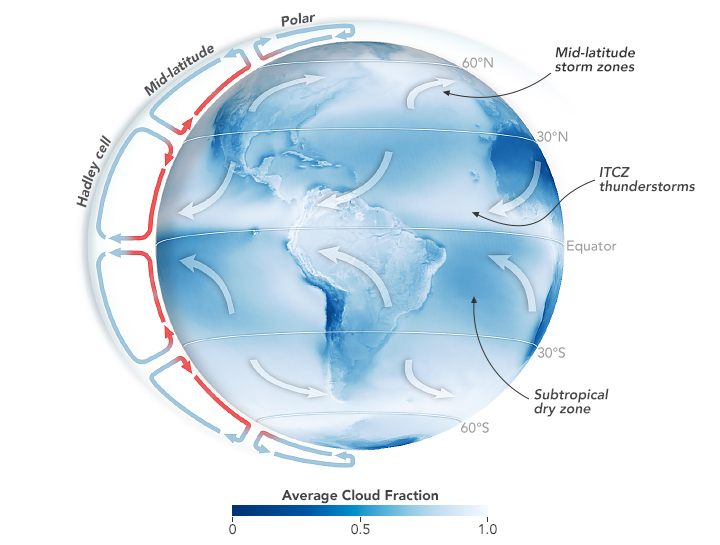
Marine storm cloud zones have shifted poleward and narrowed, and the changes are contributing to our planet’s growing energy imbalance. Credit: Michala Garrison/ NASA Earth Observatory
AGU News
AGU and IPCC partner to expand access to publications for work on Seventh Assessment Report
Access to AGU journals will provide critical climate research and data for co-authors from developing countries and anyone facing access barriers to content. [press release]
Heat wave science roundup
- Heatwave-flooding double-disasters are increasing [Geophysical Research Letters study]
- Current city planning can’t keep up with combined heat and drought events [Earth’s Future study]
- Wet heat or dry heat? Humidity lags on hottest days as climate warms [Earth’s Future study]
- Unhoused older adults struggle to cope with rising temperatures in Phoenix [GeoHealth study]
- How urban greenspace compares in Beijing and NYC, and who benefits [Earth’s Future study]
- Where to hang out to avoid heat-related emergency department visits [GeoHealth study]
- Temperature-related deaths could rise five-fold by end of century in US [GeoHealth study]
- Urban overheating risks are personal, study finds [Earth’s Future study][press release]
Featured Research
Extreme heat may raise risks of early and preterm births
Scientists looked at the births of nearly four million babies between 1990 and 2017 and found an association between preterm and early-term births during extreme heat waves, compared to the rest of the year. Heat-related preterm births (between 28 and36 weeks) were more commonly found in women over 35 whereas women under the age of 25 had a greater association with early-term births (between 37 and 38 weeks) during the hottest days of each year. [GeoHealth study][see also: flooding disasters]
Earth’s storm cloud zones are shrinking, and that means warmer oceans
Earth’s cloudiest regions form a band around the equator and in the middle latitudes, where converging winds generate storms. These bands have been contracting by 1.5% to 3% per decade since the turn of the century. The shrinkage lets more sunlight reach the surface, warming the oceans and tipping the balance of energy absorbed and energy reflected back to space. [Geophysical Research Letters study][NASA Earth Observatory graphics]
AI forecasts PM2.5 pollution at U.S. embassies and consulates worldwide
Fine particulates (PM2.5) bring serious, expensive risks for cardiovascular health. The U.S. State Department and EPA monitor air quality at 80 embassies. Researchers at NASA applied deep learning to satellite imagery, using the ground monitoring data for calibration to extend accurate 3-day forecasts to 269 embassy locations worldwide. [Earth and Space Science study]
Fracking high stress faults risks bigger earthquakes
Injecting fluids underground for fracking, wastewater disposal or geothermal energy raises pressure in the rock, which can cause small earthquakes. New research finds stress, pore pressure, and rock structure all affect earthquake magnitudes, and offers better interpretation of seismic signals to assess the risks from these projects. [Geophysical Research Letters study]
Water density shifts can drive rapid changes in AMOC strength
High-latitude variations in density, which appear to be driven by changes in atmospheric pressure, can propagate to midlatitudes and affect the current’s strength within just a year. [Eos research spotlight][Geophysical Research Letters study]
How Greenland’s glacial troughs influence ocean circulation
Glacial troughs in Antarctica promote mixing of warm and cold water, affecting global climate. A new study explores whether the same is true in troughs along Greenland’s coastline. [Eos research spotlight][ Journal of Geophysical Research Letters: Oceans study]